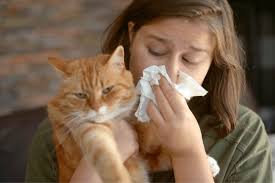Seasonal allergies are not just a human problem—they can affect our feline friends too. If your cat is sneezing more than usual, scratching excessively, or showing signs of discomfort during certain times of the year, they might be experiencing mild seasonal allergies. Understanding how to identify and treat mild seasonal allergies in cats is essential for keeping your pet healthy and comfortable.
In this article, we’ll explore everything you need to know about seasonal allergies in cats—from recognizing the symptoms to effective treatment options. Whether you’re a first-time cat owner or looking for ways to improve your pet’s wellbeing, this guide will provide clear, actionable advice.
What Are Seasonal Allergies in Cats?
Seasonal allergies, also known as allergic rhinitis or atopy in veterinary terms, occur when a cat’s immune system reacts abnormally to environmental allergens that are more prevalent during certain seasons. These allergens commonly include pollen from trees, grasses, and weeds, as well as mold spores and dust mites that flourish in particular weather conditions.
Unlike other types of allergies, such as food allergies or flea allergies, seasonal allergies tend to flare up during specific times of the year—often spring, summer, or fall—when pollen counts are high or mold levels increase.
How Do Seasonal Allergies Affect Cats?
When a cat inhales or comes into contact with an allergen, their immune system mistakenly identifies it as a threat and releases histamines to fight off the invader. This immune response leads to inflammation and irritation in areas like the skin, eyes, nose, and respiratory tract. Mild seasonal allergies often manifest as sneezing, itching, or watery eyes, but if left untreated, they can develop into more severe conditions.
Why Do Cats Develop Seasonal Allergies?
Cats develop seasonal allergies because their immune systems become sensitized to environmental allergens over time. Some cats are genetically predisposed to allergies, while others may develop sensitivities due to prolonged exposure to allergens or changes in their environment. Understanding this helps pet owners realize that allergies are not just random but often part of a complex immune response.
Summary
- Seasonal allergies in cats occur when the immune system reacts to environmental allergens like pollen, mold, and dust.
- Allergies tend to happen during certain seasons when allergen levels are high.
- Symptoms are caused by the body’s histamine response to allergens.
- Genetic predisposition and environment influence allergy development.
FAQ: What is the difference between seasonal allergies and other allergies in cats?
Seasonal allergies happen during specific times of the year and are triggered by airborne allergens like pollen and mold. Other allergies, like food or flea allergies, are caused by different triggers and can occur year-round.
What Are the Most Common Symptoms of Mild Seasonal Allergies in Cats?
Mild seasonal allergies often present with symptoms that can easily be mistaken for other issues. Here are the typical signs to watch for:
- Sneezing and coughing: Frequent sneezing is a hallmark of respiratory irritation caused by allergens. You might notice your cat sneezing more during pollen-heavy months.
- Itchy skin and excessive scratching: Allergic reactions often cause itching, leading cats to scratch or groom themselves excessively, sometimes causing hair thinning or sores.
- Watery or red eyes: Allergens can irritate the eyes, causing redness, discharge, or excessive blinking.
- Nasal discharge or congestion: Clear or slightly cloudy nasal discharge can indicate mild allergic rhinitis.
- Mild hair loss or patchy fur: Overgrooming due to itching may cause bald patches or thinning fur.
- Behavioral changes: Cats might become irritable, restless, or hide more often due to discomfort.
How Are Seasonal Allergies Different From Other Health Issues?
Distinguishing seasonal allergies from other conditions like respiratory infections, flea infestations, or skin infections is crucial. Unlike infections, allergies usually don’t cause fever or severe lethargy but may cause chronic, recurring symptoms that align with seasonal patterns.
If you notice symptoms persisting for more than a week or worsening, it’s essential to consult your veterinarian. They may recommend allergy testing or skin scrapings to rule out other causes.
High Authority Resources to Learn More:
- American Veterinary Medical Association (AVMA): — Provides detailed info on allergy symptoms and diagnosis.
- Cornell University College of Veterinary Medicine: — Expert insights on types of allergies and treatment options for cats.
- VCA Hospitals:— Comprehensive overview of causes, symptoms, and treatments.
Summary
- Mild seasonal allergies cause symptoms like sneezing, itching, watery eyes, and mild fur loss.
- These symptoms can be mistaken for other health issues, so professional diagnosis is recommended.
- Monitoring seasonal patterns and symptom frequency helps differentiate allergies from infections.
FAQ: Can mild seasonal allergies in cats be mistaken for other diseases?
Yes. Many allergy symptoms overlap with infections or flea infestations. A vet’s evaluation is important for accurate diagnosis and treatment.
What Are the Common Seasonal Allergens Affecting Cats?
- Pollen: Trees, grasses, and weeds release pollen during specific times of the year. For example, tree pollen is most common in spring, grass pollen peaks in late spring to early summer, and weed pollen often rises in late summer to fall.
- Mold Spores: Mold thrives in damp environments, especially during humid or rainy seasons. Mold spores become airborne and can trigger allergic reactions when inhaled or contacted.
- Dust Mites: While dust mites are present year-round, their populations can increase during certain seasons, especially in warmer months or in homes with high humidity.
Environmental and Lifestyle Factors Increasing Allergy Risks
- Outdoor Exposure: Cats that spend time outdoors or near open windows are more likely to be exposed to seasonal allergens like pollen and mold.
- Indoor Environment: Poor indoor air quality, dust accumulation, and mold growth indoors can also contribute to allergies.
- Breed and Genetics: Some breeds are more prone to allergies due to genetic predisposition. For example, Siamese and Oriental cats tend to have higher allergy rates.
- Age: Younger cats and those with sensitive immune systems are more susceptible to developing allergies.
- Other Health Conditions: Cats with compromised immune systems or pre-existing skin conditions may experience worsened allergic reactions.
Why Do These Allergens Trigger Allergies?
When cats inhale or come into contact with these allergens, their immune system overreacts, producing histamines and other chemicals that cause inflammation and discomfort. This immune response is similar to what happens in humans with hay fever or seasonal allergic rhinitis.
Table: Common Seasonal Allergens and Their Peak Seasons
| Allergen | Peak Season | Common Sources |
|---|---|---|
| Tree Pollen | Early Spring (March-May) | Oak, Birch, Maple, Pine |
| Grass Pollen | Late Spring to Early Summer (May-July) | Bermuda, Timothy, Ryegrass |
| Weed Pollen | Late Summer to Fall (August-October) | Ragweed, Sagebrush, Pigweed |
| Mold Spores | Spring to Fall (Varies with humidity) | Decaying leaves, soil, damp areas |
| Dust Mites | Year-round, increase in warm/humid months | Household dust |
High Authority External Resources:
- Cornell University College of Veterinary Medicine:— Comprehensive details on feline allergies and immune response.
- American College of Veterinary Dermatology: — Expert insight into environmental allergens affecting cats.
- Merck Veterinary Manual: — In-depth clinical overview of allergy causes and diagnosis in cats.
Summary
- Seasonal allergens such as pollen, mold spores, and dust mites trigger allergic reactions in cats.
- Exposure depends on outdoor environment, indoor air quality, and cat’s lifestyle.
- Genetic predisposition, breed, and immune health influence allergy risk.
FAQ: Are certain cat breeds more likely to have seasonal allergies?
Yes, breeds like Siamese and Oriental cats are known to be more prone to allergies due to their genetic makeup
Home Remedies for Managing Mild Seasonal Allergies in Cats
1. Regular Grooming:
Brushing your cat’s fur daily helps remove pollen, dust, and other allergens trapped in their coat. This reduces the amount they ingest or inhale during grooming themselves.
2. Clean Living Environment:
Maintaining a clean home can significantly reduce allergen exposure. Regular vacuuming with a HEPA filter, washing your cat’s bedding frequently, and controlling dust levels can help. Use air purifiers with HEPA filters to reduce airborne allergens indoors.
3. Limit Outdoor Exposure During Peak Allergen Times:
If your cat goes outside, try to restrict outdoor activity during high pollen times, typically mid-morning to early afternoon. Wiping your cat’s paws and fur with a damp cloth after outdoor exposure can remove allergens.
4. Diet and Supplements:
Feeding your cat a balanced diet rich in omega-3 fatty acids may help reduce inflammation and improve skin health. Some supplements, like fish oil or probiotics, can support the immune system, but always consult your vet before adding supplements.
When and How to Use Medications Safely
1. Antihistamines:
Some antihistamines like cetirizine (Zyrtec) and chlorpheniramine are occasionally prescribed by vets to relieve allergy symptoms. However, not all human antihistamines are safe for cats, and dosages vary greatly.
2. Corticosteroids:
For more persistent or severe symptoms, vets may prescribe corticosteroids to reduce inflammation quickly. These drugs should be used cautiously due to potential side effects with long-term use.
3. Natural or Herbal Remedies:
Some pet owners explore natural options like quercetin (a plant flavonoid with antihistamine properties). Though some cats benefit, clinical evidence is limited, and you should always check with your vet before starting these treatments.
4. Allergy Immunotherapy:
For cats with confirmed allergies, allergy shots (immunotherapy) can help desensitize their immune system over time. This is a long-term treatment often recommended for moderate to severe allergies.
Monitoring and Managing Symptoms Over Time
- Keep a symptom diary noting the severity and timing of symptoms. This helps your vet adjust treatment plans.
- Watch for signs of worsening, such as skin infections from scratching or breathing difficulties.
- Regular veterinary check-ups help monitor your cat’s health and tweak treatment as needed.
High Authority External Resources:
- American Veterinary Medical Association (AVMA): Managing Allergies in Pets — Guidelines on safe allergy treatments for pets.
- Cornell University College of Veterinary Medicine: Feline Allergies Treatment — Treatment options and advice for feline allergies.
- PetMD: Seasonal Allergies in Cats – Treatment and Care — Practical tips on managing mild seasonal allergies in cats.
Summary
- Home remedies focus on reducing allergen exposure and supporting skin health.
- Medications like antihistamines and corticosteroids may be necessary but require vet supervision.
- Allergy immunotherapy offers a long-term solution for confirmed allergies.
- Ongoing monitoring and veterinary care are critical to managing symptoms effectively.
FAQ: Can I give my cat human allergy medication?
No. Many human allergy medications can be harmful to cats. Always consult your veterinarian before administering any medication.
Tips to Minimize Exposure to Allergens During Peak Seasons
- Keep Windows Closed During High Pollen Times: Pollen counts tend to peak during mid-morning to early afternoon. Keeping windows and doors closed during these hours helps prevent allergens from entering your home.
- Use Air Purifiers: High-efficiency particulate air (HEPA) filters are effective in capturing airborne allergens like pollen, dust, and mold spores indoors.
- Regular Cleaning: Frequent vacuuming with a HEPA filter vacuum and dusting can help reduce indoor allergens. Washing your cat’s bedding weekly also removes accumulated allergens.
- Limit Outdoor Access: If your cat goes outside, try to limit outdoor time during peak allergy seasons, especially during high pollen days. Wiping down your cat’s fur and paws after outdoor exposure can help remove allergens.
- Maintain Humidity Levels: Keep indoor humidity between 30-50% to reduce dust mites and mold growth.
Creating an Allergy-Friendly Indoor Environment
- Use hypoallergenic bedding materials that resist dust mites.
- Avoid carpeting where allergens tend to accumulate; opt for hard flooring when possible.
- Remove houseplants that may harbor mold or release pollen.
- Consider washing your cat gently with vet-recommended hypoallergenic shampoos to remove allergens from their fur.
Importance of Diet and Lifestyle in Allergy Prevention
A healthy immune system is better equipped to handle allergens. Feeding your cat a balanced diet rich in essential fatty acids, antioxidants, and vitamins supports skin and immune health.
- Discuss with your vet about supplements like omega-3 fatty acids, which may help reduce inflammation.
- Maintain regular veterinary check-ups to monitor your cat’s health and catch early signs of allergies.
High Authority External Resources:
- American Society for the Prevention of Cruelty to Animals (ASPCA): Allergy Prevention Tips for Pets — Practical guidance on reducing allergen exposure.
- PetMD: Preventing Allergies in Cats — Tips and strategies for allergy prevention.
- American College of Veterinary Dermatology: Environmental Control for Allergic Pets — Expert advice on modifying environments to reduce allergens.
Summary
- Preventing seasonal allergies involves minimizing allergen exposure indoors and outdoors.
- Use air purifiers, maintain clean living spaces, and limit outdoor time during high pollen seasons.
- Support your cat’s immune system with a healthy diet and regular vet visits.
Frequently Asked Questions About Seasonal Allergies in Cats
Understanding mild seasonal allergies in cats can raise many questions. Here, we address the most common queries to help you care better for your feline friend.
1. What are the typical symptoms of mild seasonal allergies in cats?
Mild seasonal allergies usually cause sneezing, itchy skin, watery eyes, nasal discharge, and mild hair loss due to excessive scratching or grooming. These symptoms often align with specific times of the year when allergens like pollen are most abundant.
2. Can seasonal allergies cause serious health problems in cats?
If left untreated, mild allergies can progress to more severe issues such as skin infections, chronic ear infections, or respiratory distress. Early identification and management are crucial to prevent complications.
3. How do veterinarians diagnose seasonal allergies in cats?
Diagnosis is typically based on medical history, physical examination, and ruling out other causes like fleas or infections. In some cases, allergy testing (intradermal skin tests or blood tests) may be performed to identify specific allergens.
4. Are seasonal allergies hereditary in cats?
There is evidence that some cats are genetically predisposed to allergies. Certain breeds, like Siamese and Oriental cats, are more prone to allergic conditions, but allergies can affect any cat.
5. Can indoor cats get seasonal allergies?
Yes. Even indoor cats can develop seasonal allergies due to allergens that enter the home through open windows, on clothing, or via dust and mold inside the house.
6. Are there any natural treatments for seasonal allergies in cats?
Some natural remedies, such as omega-3 fatty acid supplements and certain herbal treatments like quercetin, may help reduce inflammation. However, their effectiveness varies, and you should always consult your veterinarian before trying alternative treatments.
7. When should I take my cat to the vet for allergy symptoms?
If symptoms persist for more than a week, worsen, or your cat develops signs like difficulty breathing, severe itching, or skin infections, seek veterinary care promptly.
High Authority External Resources for Further Reading:
- American Veterinary Medical Association (AVMA): — Trusted answers about allergies in cats.
- Cornell University College of Veterinary Medicine: — Detailed FAQs and advice.
- PetMD: — Comprehensive answers on allergy concerns in cats.
Summary
- Seasonal allergies in cats cause common symptoms like sneezing and itching but can lead to serious issues if untreated.
- Diagnosis involves ruling out other causes and sometimes allergy testing.
- Indoor cats can also suffer from seasonal allergies.
- Always consult your vet for persistent or severe symptoms.
Frequently Asked Questions About How to Identify and Treat Mild Seasonal Allergies in Cats
1. How can I tell if my cat has mild seasonal allergies or something more serious?
Mild allergies typically cause sneezing, itching, watery eyes, and mild hair loss that come and go with the seasons. More serious issues might include persistent coughing, difficulty breathing, or skin infections. If symptoms worsen or persist beyond a couple of weeks, consult your vet.
2. Are seasonal allergies common in cats?
Yes, seasonal allergies are fairly common, especially in cats exposed to outdoor allergens like pollen, mold, and dust mites.
3. Can indoor cats get seasonal allergies?
Absolutely. Allergens can enter homes on clothing, through open windows, or via indoor dust and mold, triggering allergies in indoor cats.
4. Is it safe to give my cat human allergy medicine?
No. Many human medications are toxic to cats. Always check with a veterinarian before giving any medications.
5. Can diet help reduce my cat’s allergy symptoms?
A balanced diet rich in omega-3 fatty acids can support skin health and reduce inflammation. Some supplements might help but consult your vet before making changes.
6. How can I reduce my cat’s exposure to seasonal allergens?
Limit outdoor exposure during peak pollen times, use HEPA air purifiers indoors, keep windows closed during high pollen days, and groom your cat regularly.
Conclusion: Taking Action to Identify and Treat Mild Seasonal Allergies in Cats
Mild seasonal allergies in cats can be a hidden source of discomfort and frustration for both pets and their owners. Recognizing the subtle signs — such as sneezing, itchy skin, watery eyes, and mild hair loss — is the first step to helping your feline friend feel better.
Understanding the common allergens like pollen, mold spores, and dust mites, as well as environmental factors that increase allergy risks, empowers you to take proactive measures. Simple home remedies, such as regular grooming and maintaining a clean living space, often go a long way. However, when symptoms persist or worsen, professional veterinary guidance is essential.
Treatment options vary from antihistamines and corticosteroids to long-term allergy immunotherapy, depending on the severity of your cat’s allergies. Prevention strategies including allergen reduction and supporting your cat’s immune system with a healthy diet can minimize future flare-ups.
By staying attentive to your cat’s health, monitoring symptoms, and collaborating with your vet, you can effectively manage mild seasonal allergies and ensure your cat enjoys a comfortable, happy life year-round.




